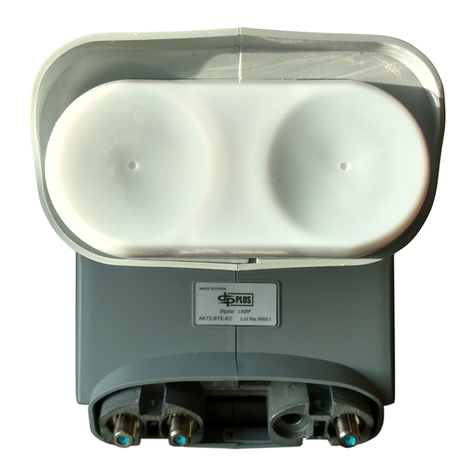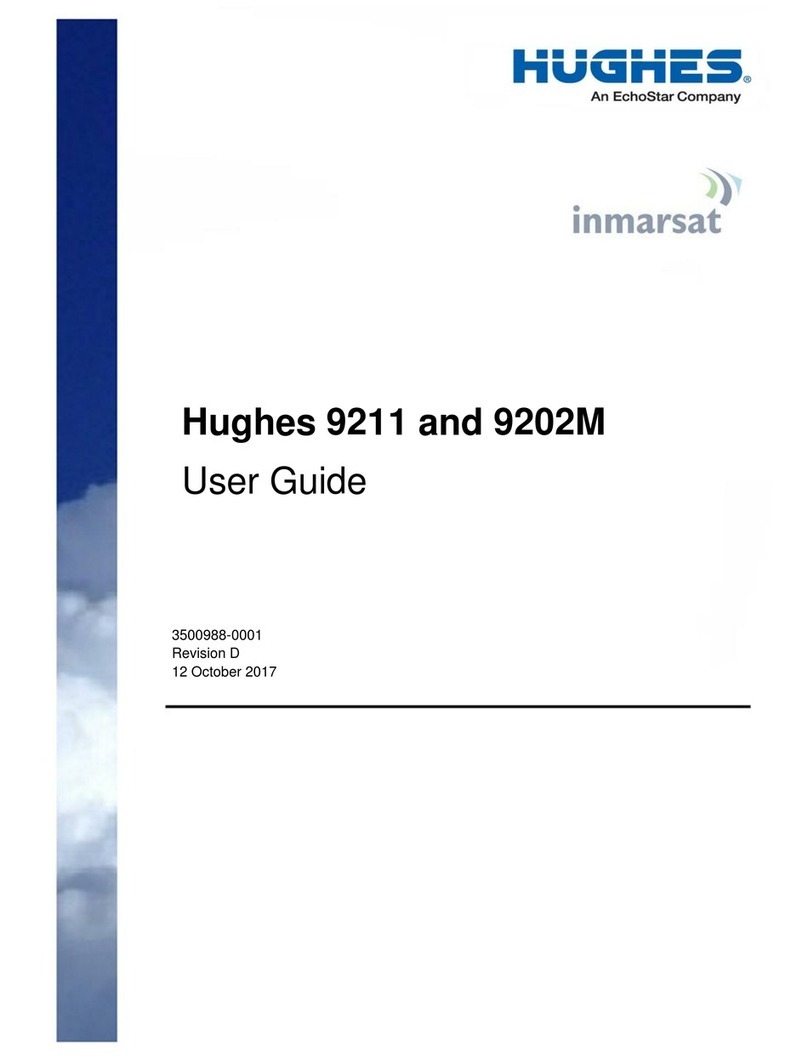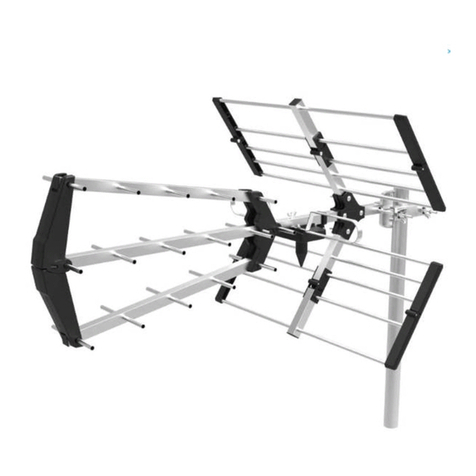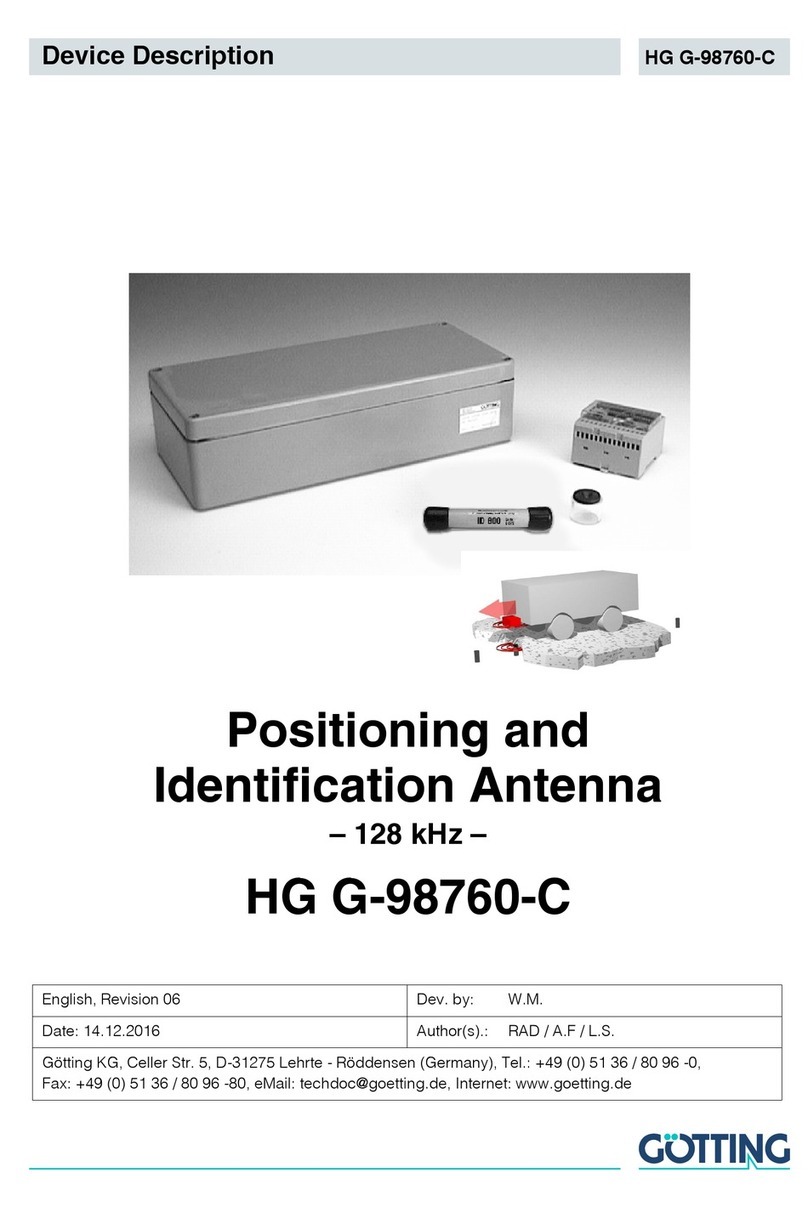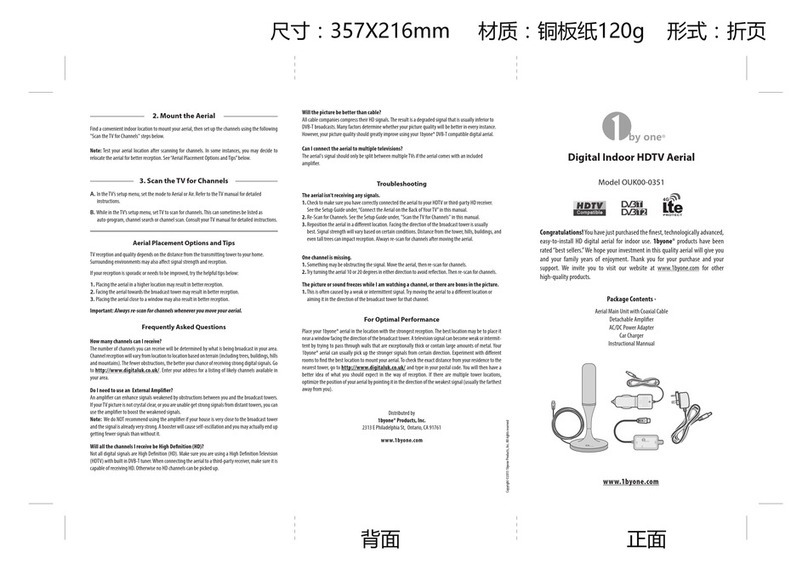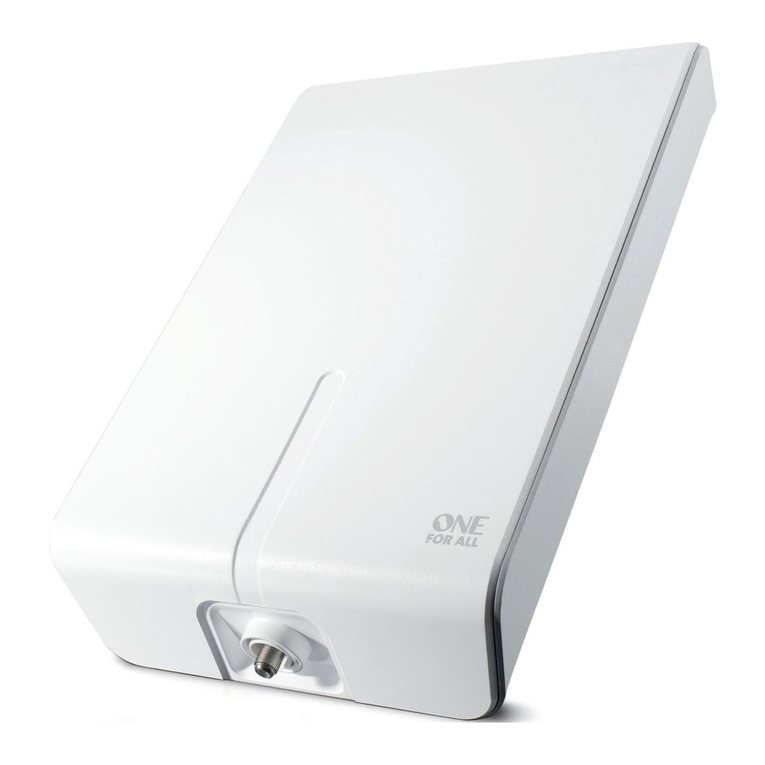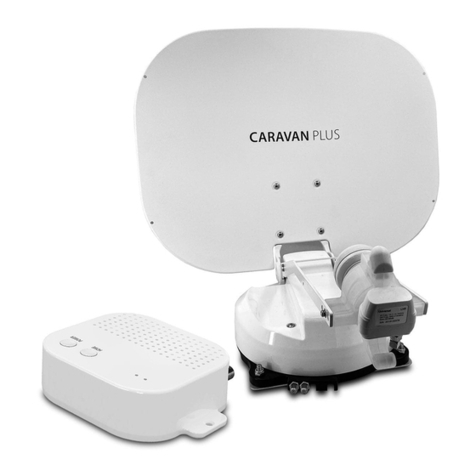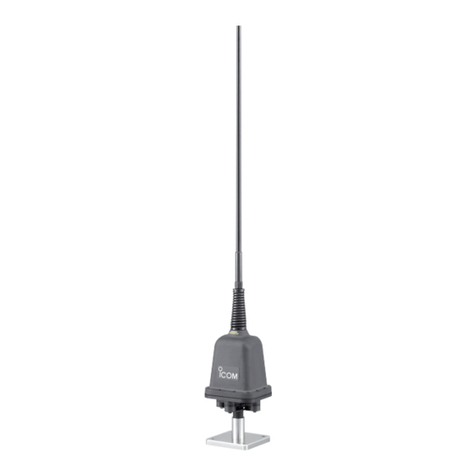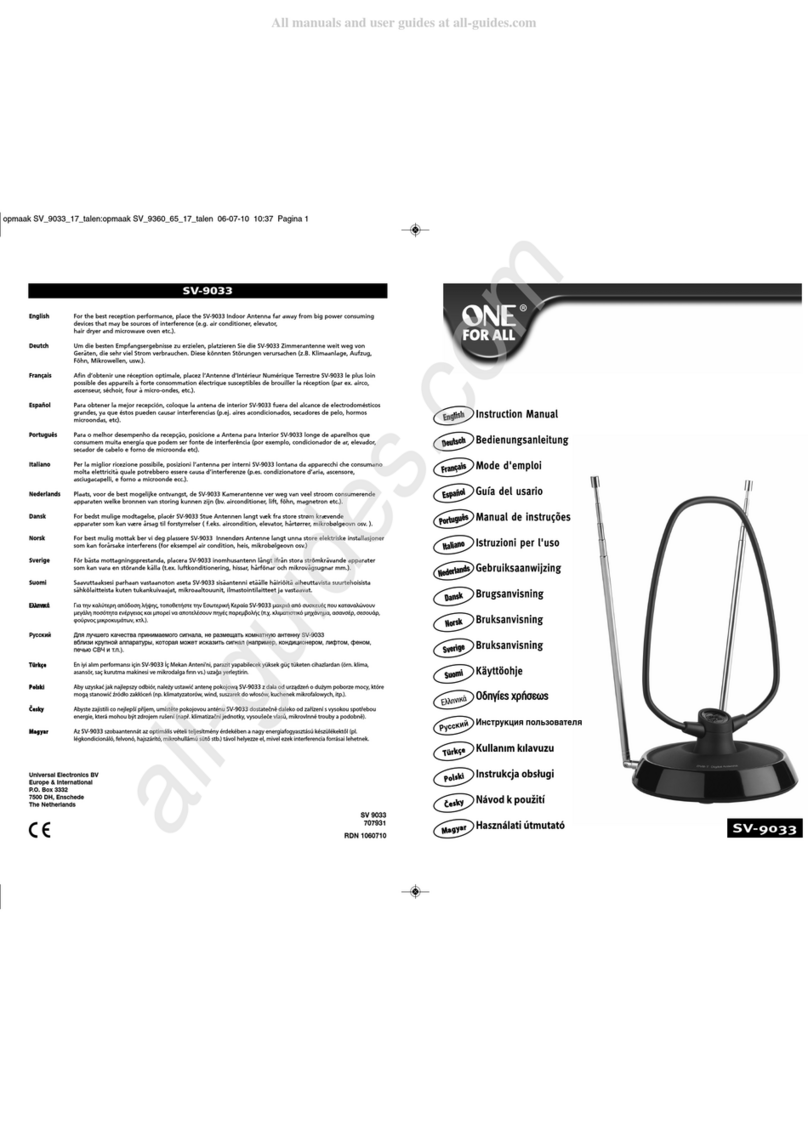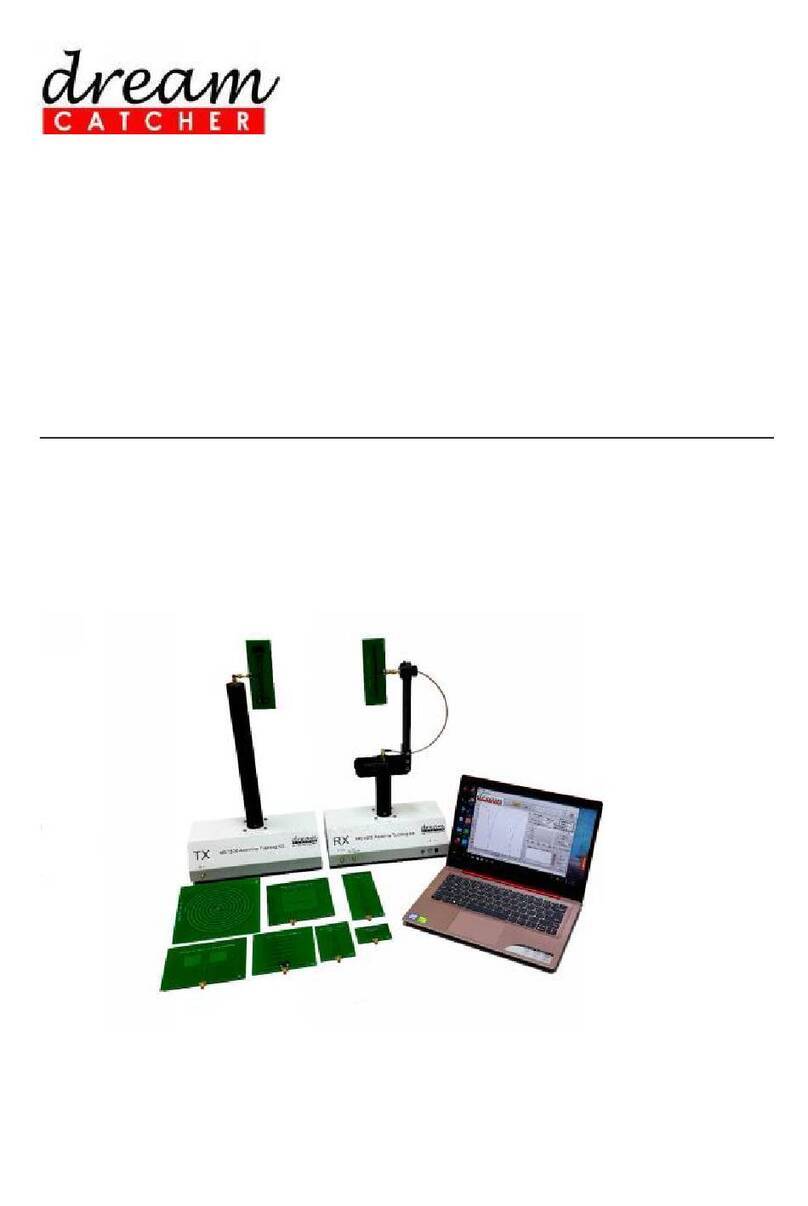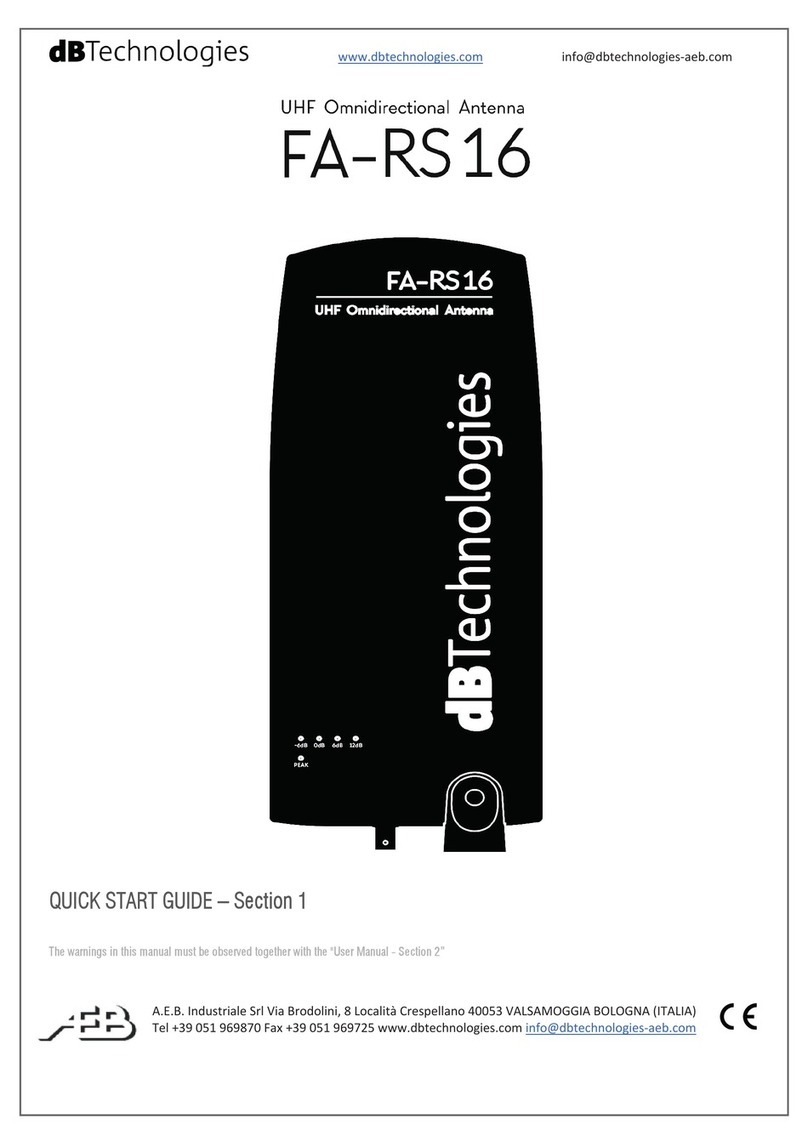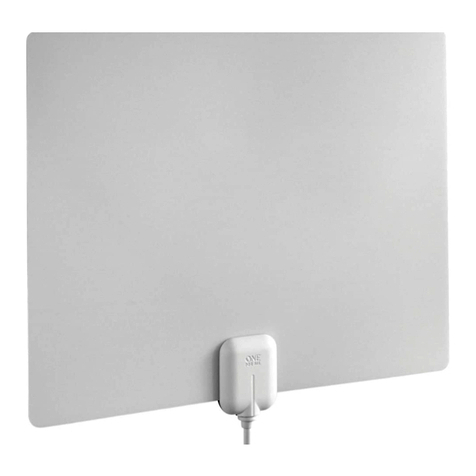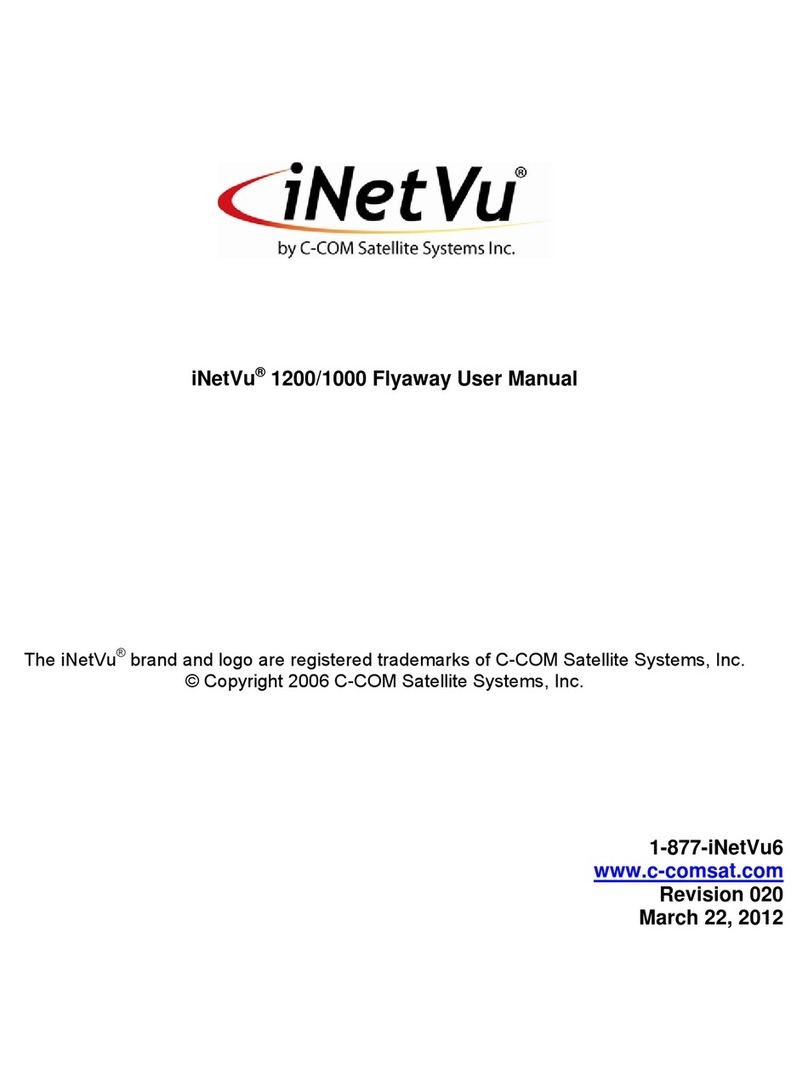EchoStar HUGHES JUPITER AN9-098-G User manual

0.98 m Antenna
Installation Guide
Model AN9-098-G
1039740-0001
Revision B
September 2, 2015
11717 Exploration Lane, Germantown, MD 20876
Phone (301) 428-5500 Fax (301) 428-1868/2830

Copyright © 2012–2013, 2015 Hughes Network Systems, LLC
All rights reserved. This publication and its contents are proprietary to Hughes Network
Systems, LLC. No part of this publication may be reproduced in any form or by any means
without the written permission of Hughes Network Systems, LLC, 11717 Exploration Lane,
Germantown, Maryland 20876.
Hughes Network Systems, LLC has made every effort to ensure the correctness and
completeness of the material in this document. Hughes Network Systems, LLC shall not be liable
for errors contained herein. The information in this document is subject to change without
notice. Hughes Network Systems, LLC makes no warranty of any kind with regard to this
material, including, but not limited to, the implied warranties of merchantability and fitness for
a particular purpose.
Trademarks
HUGHES and Hughes Network Systems are trademarks of Hughes Network Systems, LLC. All
other trademarks are the property of their respective owners.

Contents
1039740-0001 Revision B
3
Contents
Understanding safety alert messages .................................................... 5
Messages concerning personal injury.................................................................... 5
Messages concerning property damage................................................................ 5
Safety symbols ....................................................................................................... 6
Additional symbols ........................................................................................... 6
Antenna installation safety .................................................................... 7
Chapter 1
Overview............................................................................................... 11
Model AN9-098-G antenna description............................................................... 11
Antenna installation summary.............................................................................13
Approved cables .................................................................................................. 14
Chapter 2
Antenna parts and recommended tools ............................................... 15
Antenna kit components ..................................................................................... 16
Az/El mount assembly .................................................................................... 17
Reflector bracket and polarization plate........................................................18
Antenna reflector ........................................................................................... 19
Feed support arm ...........................................................................................20
Radio assembly ...............................................................................................20
Small hardware parts list ..................................................................................... 21
Tools..................................................................................................................... 22
Chapter 3
Installing the antenna and radio .......................................................... 23
General instructions for assembling the antenna ............................................... 23
Select the installation site....................................................................................24
Install the satellite modem ..................................................................................25
Determining the pointing values and polarization setting .................................. 25
Pointing values................................................................................................25
Polarization setting......................................................................................... 25
Install the antenna mount ................................................................................... 25
Installing the reflector bracket and tilt plate....................................................... 27
Installing the antenna reflector ...........................................................................29
Installing the feed support arm ...........................................................................30
Installing the radio assembly ...............................................................................34
Changing transmit circular polarization (if needed)....................................... 36
Installing the antenna assembly onto the mast .................................................. 38
Chapter 4
Cabling, connections, and grounding ................................................... 40
Cabling requirements ..........................................................................................40
Routing the IFL cable at the antenna................................................................... 41
Connecting the IFL cable......................................................................................42

4
Contents
1039740-0001 Revision B
Ground connections ............................................................................................43
Antenna mast .................................................................................................43
Radio............................................................................................................... 43
Pointing................................................................................................................ 43
Chapter 5
Adjusting antenna azimuth and elevation ........................................... 45
Adjusting azimuth ................................................................................................45
Checking the azimuth base starting position .................................................46
Coarse azimuth adjustment............................................................................ 47
Fine azimuth adjustment................................................................................ 47
Adjusting elevation ..............................................................................................48
Weatherproof the cable connections.................................................................. 50
Index .................................................................................................... 51

Understanding safety alert messages
1039740-0001 Revision B
5
Understanding safety alert messages
Safety alert messages call attention to potential safety hazards and tell you how to
avoid them. These messages are identified by the signal words DANGER, WARNING,
CAUTION, or NOTICE, as illustrated below. To avoid possible property damage,
personal injury, or in some cases possible death, read and comply with all safety
alert messages.
Messages concerning personal injury
The signal words DANGER, WARNING, and CAUTION indicate hazards that could
result in personal injury or in some cases death, as explained below. Each of these
signal words indicates the severity of the potential hazard.
DANGER indicates a potentially hazardous situation which, if not avoided, will result
in death or serious injury.
WARNING indicates a potentially hazardous situation which, if not avoided, could
result in death or serious injury.
CAUTION indicates a potentially hazardous situation which, if not avoided, could
result in minor or moderate injury.
Messages concerning property damage
A NOTICE concerns property damage only.
NOTICE is used for advisory messages concerning possible property damage,
product damage or malfunction, data loss, or other unwanted results –but not
personal injury.

6
Understanding safety alert messages
1039740-0001 Revision B
Safety symbols
The generic safety alert symbol
calls attention to a potential personal injury hazard. It appears next to the DANGER,
WARNING, and CAUTION signal words as part of the signal word label. Other
symbols may appear next to DANGER, WARNING, or CAUTION to indicate a specific
type of hazard (for example, fire or electric shock). If other hazard symbols are used
in this document they are identified in this section.
Additional symbols
This document uses the following hazard symbols:
Indicates a safety message that concerns a potential electric
shock hazard.
Indicates a safety message that concerns a potentially
hazardous situation in which you could fall.
Indicates a safety message that concerns radio frequency
(RF) energy.

Antenna installation safety
1039740-0001 Revision B
7
Antenna installation safety
Observe the following precautions when installing the satellite antenna. This
manual also includes other safety alerts where appropriate concerning specific
installation procedures.
If you work on a roof, tower, or other high structure or use a ladder or scaffold
to access the work site, follow these precautions to prevent personal injury or
death:
Walk only on sound roof structures.
Ensure that the antenna assembly and installation surface are structurally
sound so that they can support all loads (equipment weight, ice, and wind).
Use safety equipment (e.g., a lifeline) appropriate for the work location.
Follow all manufacturer safety precautions for all safety and other
equipment used.
Perform as many procedures as possible on the ground.
To avoid electric shock, stay at least 20 ft away from power lines when
there is a chance that you or the equipment you are using could come into
contact with the power lines. Always look up and check for overhead lines
before moving a ladder.
If any part of the antenna or mount assembly comes in contact with a
power line, call the local power company to remove it. Do not try to remove
it yourself. If the antenna reflector contacts electric power lines, you may
be killed or seriously injured.
For pole mount installations, be sure to obtain information regarding
underground utilities in the proposed location before digging.
Call a local company that marks underground utility lines before digging to
avoid striking underground cables, pipes, or electric lines. Call 811 from
anywhere in the United States to contact a local company that does this.
You can also visit http://call811.com/.
Striking or cutting underground cables, pipes, or electric lines can cause
personal injury or property damage.
Only Hughes‐certified installers may install or service Hughes antennas and
their components. Installers must expressly acknowledge the Hughes
requirements for Hughes installations.

8
Antenna installation safety
1039740-0001 Revision B
Do not work in high wind or rain; or if a storm, lightning, or other adverse
weather conditions are either present or approaching.
Do not attempt to assemble, move, or mount the antenna on a windy day.
Even a slight wind can unexpectedly create sudden strong forces on the
antenna surface.
Properly ground the antenna assembly in accordance with all local and
national electrical codes.
Observe these precautions to avoid exposure to RF radiation, a potential
safety hazard:
All antennas must carry an industry-standard and government-approved
Radiation Hazard Caution label on the feed support arm.
The antenna must be installed in a location not readily accessible to
children and in a manner that prevents human exposure to potentially
harmful levels of radiation.
Antennas mounted in the continental United States, Puerto Rico, or a site
with an elevation angle that is 30° or greater must be installed such that
the lower lip of the reflector is at least 4 ft 5 inches above any surface upon
which a person might be expected to stand, and 3 ft 3 inches from any
opening (such as a door or window) in a building or adjacent structure.
Antennas mounted in Canada, Alaska, Hawaii, or with a less than 30°
elevation must be installed such that the lower lip of the reflector is at least
5 ft above any surface upon which a person might be expected to stand,
and 3 ft 3 inches from any opening (such as a door or window) in a building
or adjacent structure.
The antenna must be mounted such that no object that could reasonably
be expected to support a person is within 6 ft 7 inches of the edges of a
cylindrical space that projects outward from the antenna reflector toward
the satellite and has the same diameter as the reflector. For example, the
antenna may not be installed in a place where the path of the cylindrical
space passes immediately above a deck on a nearby property. This reduces
the likelihood of a person being exposed to RF radiation because they
stood inside of or next to that cylindrical space.
If the above distance requirements cannot be met, the antenna must be
mounted in a controlled area inaccessible to the general public, such as a
fenced enclosure or on a roof.
Fenced installations must have a locked entry, and the fenced area must be
large enough to protect the general public from exposure to potentially
harmful levels of radiation.

Antenna installation safety
1039740-0001 Revision B
9
Access to a roof installation in a commercial, industrial, or institutional
environment must be limited by a door or a permanently fastened ladder
that is locked to deny access to the general public.
Fenced or roof installations in commercial, industrial, or institutional
environments must carry a Radiation Hazard Caution sign on the access
door, gate, or permanently mounted access ladder within plain sight of
anyone approaching the antenna from the front or sides of the reflector.
Once the transmitter becomes operational, maintain a safe distance; at
least 3 ft.
Failure to observe these cautions could result in injury to the eyes or other
personal injury.
Observe these precautions to avoid exposure to RF radiation, a potential
safety hazard:
•Do not remove the yellow caution label on the antenna system. All antennas
of any type or size must carry an industry standard and government
approved Radiation Hazard Caution label on the feed support arm.
•A fenced or roof installation in a commercial, industrial, or institutional
environment must carry a Radiation Hazard Caution sign on the access door,
gate, or permanently mounted access ladder within plain sight of anyone
approaching the antenna from the front or sides of the reflector.
Failure to observe these cautions could result in injury to eyes or other
personal injury.
If the antenna or mount assembly begins to fall during the installation, do not
attempt to catch it. Move away and let it fall.
Antennas that have been improperly installed or attached to an unstable
structure are susceptible to wind damage, which can be very serious or even
life threatening to you and the customer. The installer and the dealer assume
full responsibility that the installation is structurally sound to support all loads
(weight, wind, and ice) and is properly sealed against leaks.
Note: Some installations may require additional precautions. See the appropriate
site preparation and mount installation guide for more information.


Chapter 1 • Overview
1039740-0001 Revision B
11
Chapter 1
Overview
This installation guide explains how to assemble and install the Hughes AN9-098-G
0.98 m antenna. It is written for qualified installers who are familiar with satellite
antenna installation practices and are capable of properly applying the information
presented.
This chapter presents an overview of the AN9-098-G antenna, a summary of the
steps used to assemble and install the antenna, and supplemental information on
tasks related to antenna installation.
Only Hughes‐certified installers may install or service Hughes antennas and
their components. Installers must expressly acknowledge the Hughes
requirements for Hughes installations.
Model AN9-098-G antenna description
The Hughes model AN9-098-G antenna is designed for Ka‐band applications. Each
JUPITER antenna station consists of an antenna assembly and a satellite modem.
The satellite modem communicates with both the JUPITER satellite and the Network
Operations Center (NOC) using the antenna and radio assembly.
The antenna is connected to the satellite modem using a single‐cable intra‐facility
link (IFL) cable that carries both the transmit and receive signals.
Figure 1 on page 12 shows the AN9-098-G antenna—with radio assembly—
assembled and installed on a trimast mount.

12
Chapter 1 • Overview
1039740-0001 Revision B
Figure 1: Hughes model AN9-098-G 0.98 m satellite antenna

Chapter 1 • Overview
1039740-0001 Revision B
13
Antenna installation summary
Table 1 lists the basic steps and related tasks for assembling and installing the
antenna. Perform the procedures in the order listed. For detailed information on
each task, refer to the sections and/or other documents listed.
Table 1: Satellite antenna installation summary
Task
For details, see…
1
Explain the installation process to the customer.
2
Conduct a site survey with the customer to identify
a suitable location for the antenna.
Select the installation site on page 24
Appropriate site preparation and mount
installation guide
3
Use Onsite Accelerated Service Installation System
(OASIS) app on your smart device to determine
your best line of sight (LOS) before installing your
antenna, then take the required pictures.
Once you have selected the best possible location,
download your GPS coordinates within 15 m of the
selected site to get the exact settings for the
pointing values (azimuth, elevation, and tilt).
JUPITER Antenna Pointing Guide (1039429 0001)
OASIS User Guide (1040630-0001)
4
Install and apply power to the satellite modem.
Note: You must install the satellite modem before
installing the antenna to determine the
proper antenna pointing values (azimuth,
elevation, and tilt).
Appropriate satellite modem installation guide
5
Proceed with the activation and commissioning
process in OASIS (use your smart device to connect
to the satellite modem via the wireless router).
Request site latitude and longitude.
If you do not have a smart device, connect your
laptop to the satellite modem and enter the
coordinates from your GPS device when prompted.
Your GPS device must display coordinates in a
degrees/minutes/seconds format, which is
commonly found on devices manufactured by
Garmin, Magellan, etc. Some phone or tablet GPS
apps do not offer seconds measurements.
JUPITER Antenna Pointing Guide (1039429 0001)
OASIS User Guide (1040630-0001)
6
Determine the most suitable method for mounting
the antenna, then install the antenna mast.
Note: The antenna mast must be plumb. The
antenna cannot be adjusted to correct for a
mast that is not plumb.
Install the satellite modem on page 25
Appropriate site preparation and mount
installation guide

14
Chapter 1 • Overview
1039740-0001 Revision B
Task
For details, see…
7
Assemble the antenna (Az/El mount, feed support
arm, reflector, and other parts).
Chapter 3 –Installing the antenna and radio
8
Install the radio assembly
Installing the radio assembly on page 34
9
Install the antenna assembly on the mast.
Installing the antenna assembly onto the mast on
page 38
10
Install the IFL cable between the satellite modem
and the antenna.
Chapter 4 –Cabling and connections
11
Ground the antenna assembly.
Ground connections on page 43
12
Point the antenna.
Mechanical adjustments for pointing:
Chapter 5 –Adjusting antenna azimuth and
elevation
Pointing procedure:
JUPITER Antenna Pointing Guide (1039429‐0001)
OASIS User Guide (1040630-0001)
When the antenna is properly pointed, you can commission the satellite modem as
instructed in the appropriate IDU installation guide.
Approved cables
For a list of approved coaxial cable types for the IFL between the antenna and the
satellite modem, see the Hughes FSB, IFL Cable, Approved List (with lengths) for
JUPITER/HTXXXX Domestic Installations (FSB 120909_01).
The FSB lists the maximum cable length for each approved cable type.
Because the requirements and conditions for each installation site may vary, you
must use your own judgment and best practices to determine how to route and
connect the IFL cable.

Chapter 2 • Antenna parts and recommended tools
1039740-0001 Revision B
15
Chapter 2
Antenna parts and recommended tools
This chapter identifies the main components and parts provided with the
AN9-098-G Ka‐band antenna kit. It also provides a list of required tools you will
need to successfully perform the installation.
Figure 2: Antenna parts

16
Chapter 2 • Antenna parts and recommended tools
1039740-0001 Revision B
Antenna kit components
Note: The radio assembly is shipped separately from the rest of the antenna and
may not arrive at the same time.
When you receive the antenna equipment, unpack and inspect the components and
hardware to ensure that all parts have been received in good condition.
Metal components may contain sharp edges. Use care when unpacking and
handling antenna parts.
If any parts appear to have been damaged in transit, immediately contact the
freight carrier. If any parts appear to be missing or damaged, but not as a result of
handling in transit, contact your dealer or distributor.
Note: To avoid potential damage, leave all components in their protective
packages until required.
The main components of the antenna kit are:
Az/El mount assembly
Reflector bracket and polarization plate
Antenna reflector
Feed support arm and feed tube adapter
Side support rods
Radio assembly (shipped separately) with feed horn attached
The following sections describe and illustrate each component of the antenna kit.

Chapter 2 • Antenna parts and recommended tools
1039740-0001 Revision B
17
Az/El mount assembly
The Az/El mount assembly, shown in Figure 3, includes components that allow you
to adjust the antenna elevation and azimuth—the Az/El canister, the elevation
scale, and the azimuth and elevation adjustment tools. It also includes a grounding
screw, used to ground the assembly to the grounding block.
The Az/El canister supports the antenna and secures it to the mast. The elevation
scale is used to measure the angle of antenna elevation. The azimuth and elevation
adjustment tools are used to finely adjust the azimuth and elevation of the reflector
during antenna pointing. See the JUPITER Antenna Pointing Guide (1039429‐0001)
for detailed instructions.
Figure 3: Az/El mount assembly

18
Chapter 2 • Antenna parts and recommended tools
1039740-0001 Revision B
Reflector bracket and polarization plate
The reflector bracket shown in Figure 4 attaches to the Az/El mount and supports
the antenna reflector. The tilt plate allows the reflector to rotate so that it can be
adjusted for proper tilt. (See also Figure 9 on page 27.)
Figure 4: Reflector bracket and tilt plate
Tilt plate
Reflector bracket

Chapter 2 • Antenna parts and recommended tools
1039740-0001 Revision B
19
Antenna reflector
The antenna reflector shown in Figure 5 focuses the transmitted and received RF
signals. It attaches to the reflector bracket.
Figure 5: Antenna reflector
Handle the antenna reflector with care to avoid bending it or causing other
damage.

20
Chapter 2 • Antenna parts and recommended tools
1039740-0001 Revision B
Feed support arm
Figure 6 shows the feed support arm, which supports the radio assembly and
feed horn.
Figure 6: Feed support arm
Radio assembly
The radio assembly shown in Figure 7 consists of the radio transmitter/receiver,
polarizer waveguide, and feed horn.
Figure 7: Radio assembly
Radiation exposure label
Table of contents
Other EchoStar Antenna manuals
